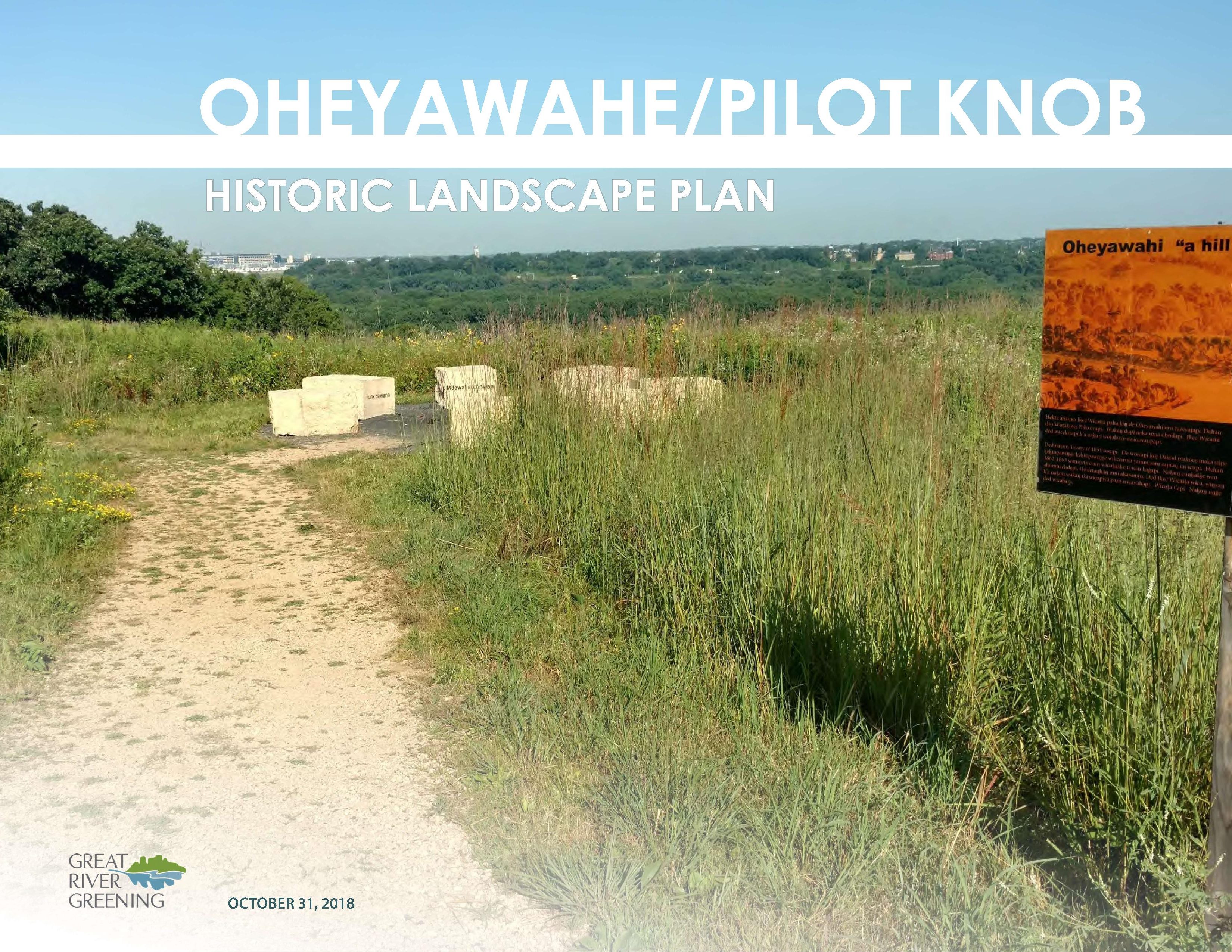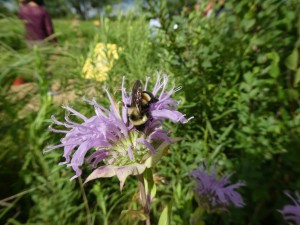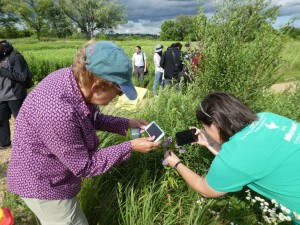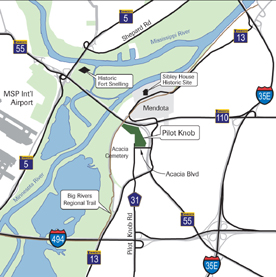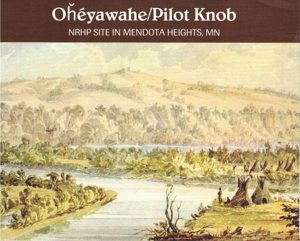By Leslie Pilgrim
Historic Pilot Knob: Perfectly Perched in the Fast Lane
Historic Pilot Knob is located within one of the world’s amazing bird migratory routes: The Mississippi Flyway. Every year, over 325 bird species migrate via the flyway from their breeding grounds in Canada and the northern United States to their wintering grounds in the Gulf of Mexico, or beyond, to Central and South America. About 40 percent of all North American waterfowl and shorebirds use the Mississippi River corridor as a migratory flyway. And overall, the Mississippi Flyway is the approximate migratory route for nearly half of North America’s birds.
Located on the bluffs above the confluence of the Mississippi and Minnesota Rivers, historic Pilot Knob is perfectly perched in the fast-lane of this avian superhighway. Its bluff-top location in the flyway means great opportunities to spot a wide range of birds—from seasonal migratory visitors, to birds that remain year round. While peak migration takes place in May, September, and October, birding on this bluff is rewarding in any season.

The adult great blue heron can have a wingspan of up to seven feet in length. In the winter, these birds migrate to ice-free coastal areas and waterways in the southeast United States, as well as the Caribbean. Photo courtesy of Travis Bonovsky
The Flyway of Centuries Past
The present-day network of dams, levees, and locks has reduced the Mississippi floodplain to less than ten percent of its original size. It is estimated that 19 square miles of wetlands in the southern delta area of the United States disappear each year. Loss of habitat has greatly diminished the number of species and quantity of birds from what traveled the flyway in centuries past.
“Before the Mississippi River was dammed, the river valley was a vast floodplain,” explains Chase Davies, society board secretary for the St. Paul chapter of the Audubon Society. “Because of the close proximity to water, vegetative layering, diverse habitat and food sources, there was an incredible diversity of bird species and numbers of birds in this area.” Davies believes one can get a small glimpse of what the floodplain that existed in the Twin Cities metropolitan area may have been like by visiting Trempealeau National Wildlife Refuge in Wisconsin—a 6,500-acre refuge that offers robust, biodiverse avian breeding habitat. Having experienced the relative lushness of the Trempealeau refuge, Davies understands why historic Pilot Knob, with its bluff prairies overlooking the floodplain and the confluence of two rivers, and the accompanying abundance of wildlife, were so attractive to the Dakota. “This area must have been a hotbed of activity in so many ways,” she surmises.

The U.S. is comprised of four distinct migratory flyways that are used by birds to travel from breeding to wintering grounds and back. Click here to watch the tracking of 118 bird species migration patterns in the Western hemisphere. Note that some birds do not fly south the same way they fly north. Image courtesy of U.S. Fish & Wildlife Service.
An Important Bird Area
While the flyway may not have the bounteous wildlife that it once had, the corridor that passes through the Twin Cities remains an important area for birds. In fact, an “Important Bird Area” (IBA), is an area that has been specifically identified by the national Audubon Society as crucial in order “to identify, monitor, and protect the most important places for birds” so that areas vital to birds can be conserved. Audubon has “identified 2,758 IBAs covering 417 million acres of public and private lands in the United States. Among these are high-priority Global IBAs—places like New York City’s Jamaica Bay, areas within Alaska’s Arctic Slope, and coastal bird sanctuaries in Texas.”
Historic Pilot Knob lies within one of the 57 Minnesota IBAs identified by the Audubon Society (in conjunction with Audubon Minnesota). It is located on the border of the Mississippi River Twin Cites/Lower Minnesota River Valley IBAs. These IBAs are situated in the most densely populated and highly urbanized portion of Minnesota. (See map for IBAs in the Twin Cities as well as Minnesota.) Lying within an IBA, as well as the flyway, adds another layer of importance to the ongoing restoration and stewardship work taking place on “the hill much visited.” Shorebirds and waterfowl—which include geese, swans, herons, egrets, eagles, dabbling and diving ducks, coots, grebes, kingfishers, cormorants, terns, and so many more—need the river for sustenance or breeding habitat. While these birds rely primarily on the river, Pilot Knob offers a great vantage point for viewing birds that ride thermals (such as bald eagles), or water birds that pass overhead (such as egrets, herons, or a variety of ducks and geese).
Many terrestrial (land) birds (96 percent of which feed only insects to their young) that feed fully or partly on insects, enjoy the bounty of insects that are attracted to the native vegetation on Pilot Knob’s restored prairie. Many birds are also attracted to the seedheads of fall native prairie forbs and grasses. Migratory visitors also take advantage of the habitat, food sources, and biodiversity of Pilot Knob’s restored landscape. In the fall as these migratory birds prepare to depart on long journeys toward warmer climates, they enter a state of increased appetite known as hyperphagia, which compels birds to bulk up to create reserves of fat. The 25 acres of historic Pilot Knob make their offering of insects, seeds, and small rodents so that these travelers can, hopefully, make successful journeys to their wintering grounds.
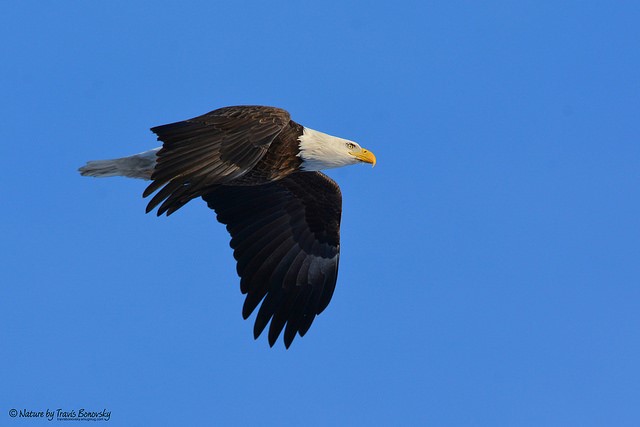
The trademark white head and tail feathers of the bald eagle do not appear until it reaches age four or five. Bald eagles can often be seen soaring above and near Historic Pilot Knob.
Photo courtesy of Travis Bonvosky.
A Birder’s Paradise
Historic Pilot Knob is but one part of a “birder’s paradise” in the immediate area. A short hike on the river flats below historic Pilot Knob lies Gun Club Lake. Across the river on the river bottoms is Fort Snelling State Park. And the Minnesota Valley National Wildlife Refuge lies slightly downstream southwest of Pilot Knob. All of these sites lie in the IBA/Mississippi Flyway and offer rich opportunities to enjoy birds of all types: waterfowl, migratory visitors, and year round residents. Fort Snelling State Park has compiled a great birding list for this IBA. For more information on the importance of IBAs, click here.

Goldfinch with seeds of the meadow blazing star. Historic Pilot Knob is located within an Important Bird Area (IBA). The goal of the IBA program, according to the National Audubon Society, is to “ensure the survival of wild bird populations through the identification and protection of their most important habitats.”
Photo courtesy of Travis Bonovsky.






